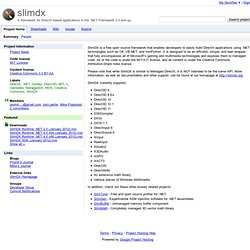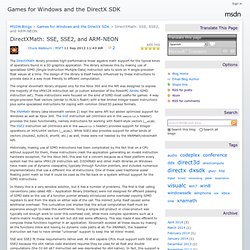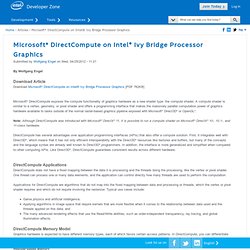

Blogs. DirectX Tool Kit - Home. Slimdx - A framework for DirectX based applications in the .NET Framework 2.0 and up. SlimDX is a free open source framework that enables developers to easily build DirectX applications using .NET technologies such as C#, VB.NET, and IronPython.

It is designed to be an efficient, simple, and lean wrapper that fully encompasses all of Microsoft's gaming and multimedia technologies and exposes them to managed code. All of the code is under the MIT/X11 license, and all content is under the Creative Commons Attribution-Share Alike license. Please note that while SlimDX is similar to Managed DirectX, it is NOT intended to be the same API.
More information, as well as documentation and other support, can be found at our homepage at SlimDX currently supports: Direct3D 9 Direct3D 9 Ex Direct3D 10 Direct3D 10.1 Direct3D 11 D3DCompiler DXGI DXGI 1.1 DirectInput 8 DirectSound 8 XInput RawInput XAudio2 X3DAudio XAPO XACT3 Direct2D DirectWrite An extensive math library Various pieces of Windows Multimedia In addition, check out these other loosely related projects:
Beginners: DirectX 3D graphics with DirectX tutorial, tutorial part 1 - Secret Microsoft Communications. Yep, I wrote the word tutorial twice, TWICE!

Why? Beginner: Create shaders and drawing primitives tutorial, tutorial part 2 - Secret Microsoft Communications. (Changes made to blog on 8/14/2013) Well, there is that tutorial twice thing, but this is part 2.

Here are some added tips that are useful for the tutorial at: Create shaders and drawing primitives First a video on how to quickly add the hlsl files to your project, it is only a minute or so in length. How to quickly add the vertex shader and pixel shader files to VS 2013 HLSL files do not have intellisense, so will act like textfiles. Keenan Crane. Free: 11 Windows 8.1 DirectX links - Secret Microsoft Communications.
Games for Windows and the DirectX SDK.
Spherical Harmonics Math - Games for Windows and the DirectX SDK. DirectXMath (aka XNAMath version 3) provides almost all the functionality of the original D3DXMath library with two exceptions.

The first is the 'matrix stack' helper and the second is the 'spherical harmonics' math functions. The matrix stack is fairly easy to implement, but the SH math functions are another story. DirectXMath: SSE, SSE2, and ARM-NEON - Games for Windows and the DirectX SDK. The DirectXMath library provides high-performance linear algebra math support for the typical kinds of operations found in a 3D graphics application.

The library achieves this by making use of specialized SIMD (Single-Instruction-Multiple-Data) instruction sets to work on 4 single-precision float values at a time. The design of the library is itself heavily influenced by these instructions to provide data in a way most friendly to efficient computation. The original xboxmath library shipped only for the Xbox 360 and the API was designed to expose the majority of the VMX128 instruction set (a custom extension of the PowerPC AltiVec SIMD instruction set). These instructions were focused on the kind of SIMD most useful for games: 4-way single-precision float vectors (similar to HLSL’s float4) with a few limited integer-based instructions plus some specialized instructions for coping with common Direct3D packed formats. SSE and SSE2 fit these requirements rather well. DirectX Tool Kit - Home.
DirectXTK Simple Sample (Windows 8.1) in C++ for Visual Studio 2013. Microsoft* DirectCompute on Intel® Ivy Bridge Processor Graphics. By Wolfgang Engel Download Article Download Microsoft* DirectCompute on Intel® Ivy Bridge Processor Graphics [PDF 762KB] Microsoft* DirectCompute exposes the compute functionality of graphics hardware as a new shader type: the compute shader.

A compute shader is similar to a vertex, geometry, or pixel shader and offers a programming interface that makes the massively parallel computation power of graphics hardware available to tasks outside of the normal raster-based graphics pipeline exposed with Microsoft* Direct3D* or OpenGL*. Note: Although DirectCompute was introduced with Microsoft* DirectX* 11, it is possible to run a compute shader on Microsoft* DirectX* 10-, 10.1-, and 11-class hardware. DirectCompute has several advantages over application programming interfaces (APIs) that also offer a compute solution. DirectCompute Applications DirectCompute does not have a fixed mapping between the data it is processing and the threads doing the processing, like the vertex or pixel shader. A managed path to DirectCompute. After NVidia Cuda, OpenCL we got DirectX’s version (of GPGPU parallelism for numerical calculations) named DirectCompute.

All three technologies are very similar and have one goal: to provide some sort of API and shader language for numerical calculations that GPGPU is capable of. And if you use it wisely the performance gains over normal CPU are huge, really huge. Not just that you offload CPU but the calculations due to GPGPU massive multithreading (and multicore) are much faster compared to even the most advanced x64 CPU. It works like this: you prepare enough data that can be worked on in parallel, send it to GPGPU, wait till GPGPU finished processing the data and fetch the results back to the CPU where your application can use them.
You can achieve up to a TFLOP with a graphics card sold today. I guess this information is enough to see what is all about. DirectCompute. DirectCompute stuff! DirectXTex texture processing library - Home.